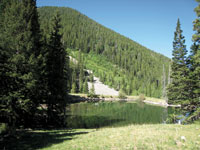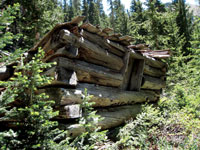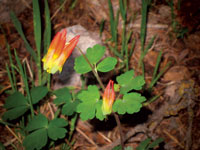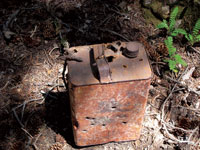HIKING HAPPENINGS AUGUST 2012 Miners Basin To Bachelors Basin – Remnants Of Times Gone By A rubble-of-rock road in a narrow mountain canyon equates to a bumpy, bone-rattling drive - a jolting keep-you-awake ride, especially when there’s no place to pull over for an oncoming vehicle! After bouncing along at a snail’s pace for three tedious miles, we finally arrive at the Miners Basin parking area where the sudden lack of momentum feels amazingly good.
Only a few buildings remain– enough, however, to spark the imagination of what must have been. By July 1899, the population had exploded to almost 70 – twelve of them women. This bustling town, which was referred to as “The Basin”, had 27 cabins, a grocery store, two restaurants, two saloons, a hotel and boarding house where dances were held, a livery and feed stable, shoemaker’s shop, mining office, deputy sheriff, post office and a Sunday School.
But the miner’s dreams of getting rich faded fast. The gold discovered in 1897 turned out to be a low-grade ore - and with an economic downturn in 1907 – boom turned to bust. By 1910 probably less than a dozen people remained. A short distance beyond “The Basin” - around the bend of a switchback - a small wooden structure pops into view. This historic remnant provides a handy excuse to stop and poke around to look at all the nearby memorabilia – an ore cart, a mineshaft called the Dillon Tunnel, and a stream that gushes from its opening as it flows across a tailings pile.
I’ve walked this road before and coming upon the remains of an old building, I think that my climb is coming to an end. My memory, however, deceives me. I don’t remember it being this much further to the top! It’s been a steady uphill grunt for way too long, and when I finally do get to the pass with a wide-open western view of Behind The Rocks, Moab and the Henry Mountains, I am ready for lunch! Letting my heavy pack plop to the ground, I immediately lean back against a rock to enjoy the coolness of a hefty breeze that sways the tall skinny firs highlighted against a soft blue sky. A swath of bright yellow draws my attention to a wealth of golden banner flowers providing a bounty of nectar for a variety of butterflies, who drift from blossom to blossom, sampling the sweet goodies while bees busily make their own appointed rounds.
Once up and on the march again, I immediately walk past the old road on the left that goes to Willow Basin. A little further a cairn marks the continuation of the Trans La Sal Trail that connects up with the old road. Through this stretch I am delighted to find a wealth of blue columbines – exquisitely designed beauties that are a trademark of the high country.
|
|||||||||||||||||||
© 2002-2024 Copyright Moab Happenings. All rights reserved.
Reproduction of information contained in this site is expressly prohibited without the written permission of the publisher.














